Whales, dolphins and porpoises hold a very special place in people’s hearts and minds. It may be a very long time since our shared mammalian ancestors went their respective ways, but when we get anywhere near “the cousins” in their watery world, there’s a special feeling. Particularly so when the individual involved is Fungi the bottlenose dolphin of Dingle, with his hopes for appreciative human company being stymied for now by the pandemic restrictions, even as his usual sociable season with its requirement for an appreciative audience moves towards its midsummer heights.
Those of us who have a gut feeling that the Covid-19 is going to be gone from Ireland like snow off a ditch by the end of May, well, we keep our notions to ourselves out of respect for the continuing heroic struggle of the frontline workers, and the specialists and those who provide them with management backup. And yes, we do accept that there’s a fair chance that it will return as autumn’s damp and cold and gloom descends on us. But in the meantime, there’s going to be a summertime window of opportunity, and we’ll all go mad if we don’t use it.
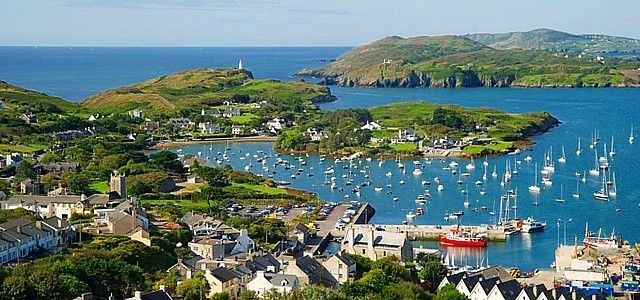 The Cove in Baltimore, where the pilot whale Albert was still an occasional presence in his final days in 1968
The Cove in Baltimore, where the pilot whale Albert was still an occasional presence in his final days in 1968
Meanwhile, the story of Fungi’s frustration here on Afloat.ie last week was clicking vigorously, as was Betty Armstrong’s subsequent story about a pod of orca whales in Strangford Lough. But there was an added dimension to the Fungi yarn, with our query as to whether anyone remembered Albert, the dolphin or pilot whale who used to make his home in and around Baltimore, and was into occasional interaction with moored cruising yachts. He reputedly enjoying the trick of gathering up the cruising folk’s ground tackle as they lay anchored for the night off Baltimore, and leaving them such that they woke up to find themselves anchored off Sherkin.
It was a memory which hit the spot among Afloat.ie viewers. Bells rang out, and pensioners danced in the streets - or more accurately, they leapt to their Smartphones and iPads, and we soon had enough facts and figures to form an Albert the Pilot Whale of Baltimore Club.
Brian Marten, well known for his work in the local community in West Cork and also for commissioning the re-birth of the 1893 Baltimore-built gaff cutter Eva as Guillemot by Liam Hegarty at Oldcourt, is right there with chapter and verse:
 Spirit of Baltimore: Brian Marten’s Guillemot – originally built as Eva in Baltimore in 1893 – is another successful Liam Hegarty restoration. Photo: Robbie Murphy
Spirit of Baltimore: Brian Marten’s Guillemot – originally built as Eva in Baltimore in 1893 – is another successful Liam Hegarty restoration. Photo: Robbie Murphy
“Sailing around Baltimore as a schoolboy, encounters with Albert were very common - he liked to hang around the Catalogues, (between Sherkin and Heir Island, west of Turk Head, I'm sure you know them). I often saw him jump clear out of the water one or more times in that channel. I recall seeing him jump out of the water near Sherkin when I was very small, one of my earliest memories. I believe that he disappeared some time in the late 1960's, probably died of old age. I don't think a carcass was ever reported.
He most definitely was not a dolphin, being much larger, probably at least 15ft to 18ft long as I recall. I usually saw him while in my brother Alan's National 18 (Alan Marten is currently co-owner of the classic River Class sloop Gweebarra in Strangford Lough, where he is a former Commodore of Strangford Lough YC).
People said Albert was a Pilot Whale, as you mention, but that may have been hearsay. There must have marine biologists around at the time who knew exactly what type he was. I say "he", as he was always referred to as masculine. Anyway, he never had babies, though to be fair that would have required two of the species.
We would usually hear him blowing in the harbour on a quiet night while walking back to the Cove from Dinny Salter’s (now Bushe’s).”
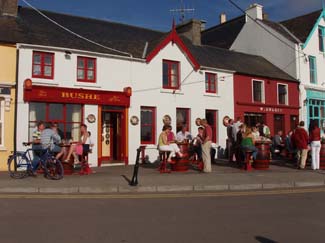 West Cork oasis – Bushe’s of Baltimore was still Dinny Salter’s when Albert the Pilot Whale was part of the local scene
West Cork oasis – Bushe’s of Baltimore was still Dinny Salter’s when Albert the Pilot Whale was part of the local scene
The proper slaking of thirsts in Baltimore was always a sensible priority, but right now the thirst is of the boats and their timberwork, and the challenge down there is to get the local fleet of traditional and classic wooden boats afloat as soon as possible after the Lockdown paralysis, which in recent weeks had been subjecting them ashore to excessive temperatures (both high and low) and searing sunshine
But as to Albert, it seems he was a Pilot Whale, and Brian’s estimate of a length of 15ft to 18ft (5.5 metres) hits the spot, whereas a bottlenose dolphin barely gets to 4 metres, though I’d say Fungi is all of that. Certainly, it means that if he were of a hostile nature, he could be a real menace, and a couple of years ago attempts to befriend and swim with a bottlenose dolphin at Doolin in County Clare went astray, with people being injured.
As for the leaping from the water, that seems to be both sheer exuberance, and the need to shake off sea lice. When a creature the size of Albert did it within the confines of Baltimore Harbour, it was quite something, but occasionally basking sharks do the same, and in recent years that inveterate ocean observer Youen Jacob of Baltimore has recorded basking sharks in the neighbourhood making their leap for freedom.
 He’s kind of all over the place, but at least he’s doing it – the rare sight of a basking shark jumping, as recorded by Youen Jacob of Baltimore. Photo: Youen Jacob
He’s kind of all over the place, but at least he’s doing it – the rare sight of a basking shark jumping, as recorded by Youen Jacob of Baltimore. Photo: Youen Jacob
Back in 1961 when I was cruising solo in a 23-footer off the west coast of Scotland, the word was out that basking sharks were a-leaping at the north end of Kilbrannan Sound between Arran and Kintyre. This was interesting – in the Chinese Mandarins’ interpretation of the word – as I wanted to sail up the Sound from Campbeltown to Tarbert, and sure enough off northwest Arran, there were some mighty splashes around. We – the little boat and me – were sailing along holding to the Kintyre shore thinking we were safe enough, when some eccentric biggie decided that this was exactly where he wanted to let his sea lice get off.
It seemed to me he jumped much more than the 1.2 metres which is all that basking sharks are supposed to achieve, suggesting he might have been a pilot whale. But either way, he was much too close for comfort, and I wasn’t in a species-identifying frame of mind, being just mighty glad there was only the one performance.
That night in the pub in Tarbert, the barman relished telling me that some years previously, there’d been another spate of shark-jumping in the same area. A boat only slightly larger than mine was sitting becalmed off Loch Ranza on the Arran shore, with two crew on board, when a very large basking shark or pilot whale shot blindly upwards out of the water and landed plumb on top of them, leaving only matchwood, with the bodies never found.
So maybe back in the 1930s, 40s, 50s and 60s when Albert was making the scene around Baltimore, it was common sense to accept that he was big enough to be accidentally dangerous, and anyway any notion of making him into a tourist attraction would generally have been out of kilter with the rather solemn mood of the time.
But his memory still evokes other memories, and former Baltimore Sailing Club Commodore Gerald O’Flynn wrote:
“Regarding your article on Fungi, you made reference to Albert who resided in Baltimore Harbour and its environs for many years. The late Tom Fuller, who was the founder of Baltimore Sailing Club in 1956, often told the story of Albert. He first became aware of Albert in the early '30s, and around that time he was asked by some local fishermen to "take care of that bastard!”
But Tom always thought he was an addition to the harbour, and always liked to be told when and where we saw him. Albert was a constant presence in the 50s and 60s, when he would suddenly loom up alongside, which was quite intimidating when aboard a National 12 dinghy.
My brother Dom was the last of our family to experience him - that was when he lived in the Cove around 1968. In bad weather, he said, you could hear Albert snorting away in the sheltered Cove at night. Personally, I didn’t see or hear him after the early 60's. We always thought that he was bigger than a dolphin, but that might have been because he didn’t seem to have a dolphin’s beaked nose – it was definitely a rounded one.
I’ve been a member of the Baltimore SC since its foundation in 1956, and was Commodore in 84/85. I remember meeting you on a few occasions - one in particular with the late Hugh Kennedy, when you’d sailed in to Baltimore on a cruise to the West Cork Regatttas, and we attempted to put the world to rights one sunny afternoon.”
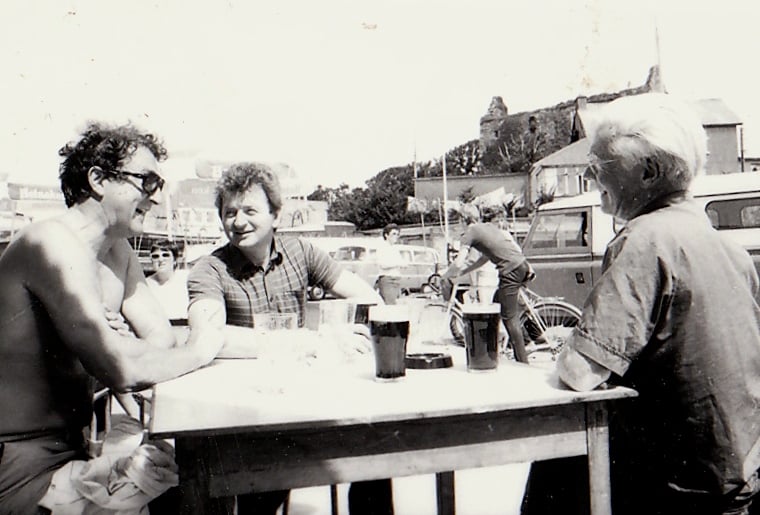 Putting the world to rights – Baltimore in the summer of 1984, with (left to right) Hugh Kennedy, Dom O’Flynn, Brendan Cassidy, and beyond him the castle, without its roof in those distant days. Photo: W M Nixon
Putting the world to rights – Baltimore in the summer of 1984, with (left to right) Hugh Kennedy, Dom O’Flynn, Brendan Cassidy, and beyond him the castle, without its roof in those distant days. Photo: W M Nixon
Memories, memories. Tom Fuller was indeed a lovely man, with vision ahead of his time. Thanks to Ger O’Flynn, we now know that way back in the 1930s, there was at least one person in Baltimore who appreciated that there was potentially much more to Albert than a nuisance who consumed vast quantities of fish.
As for that remembered gathering in the sunshine in Baltimore, it was 1984, and we were in West Cork with our visit built around the Centenary of Schull Regatta which was in the midst of the West Cork Regattas when they were in more traditional form. Thus Ger and his late brother Dom (who also served as a BSC Commodore) were in the throes of preparation for Baltimore Regatta on the Bank Holiday Monday, but “urgency” acquires a more relaxed meaning in summertime in Baltimore, and though Ger had nipped away to sort some little problems when I took the photo of Hugh Kennedy, Dom O’Flynn and Brendan Cassidy of Howth undoubtedly putting the world to rights in the sunshine, everything took place as expected.
It was something of a miracle we were there at all, as mid-July bad seen us handling the Press Office at ISORA Week, then we’d set off with our little Hustler 30 Turtle for an ambitious cruise taking in southwest Wales including inveigling our way ashore on the monastic island of Caldey, a night at Lundy in the midst of the Bristol Channel, round Land’s End for a few days in Falmouth where the family were on holiday, a proper little visit to the Isles of Scilly, and then nor’west to West Cork and suddenly there we were, on the quay in Baltimore, and a full plenary session in place.
Even at Schull Centenary Regatta when the wind failed completely, it was no problem - they decided that Michael O’Leary of Dun Laoghaire with the Holland 39 classic Imp had clearly been shaping up to be the winner, so they simply moved the finishing line out to the completely becalmed Imp by dropping the outer mark on one side of Imp, then taking the committee boat round to the other, and then firing the gun to make him line honours and corrected time winner.
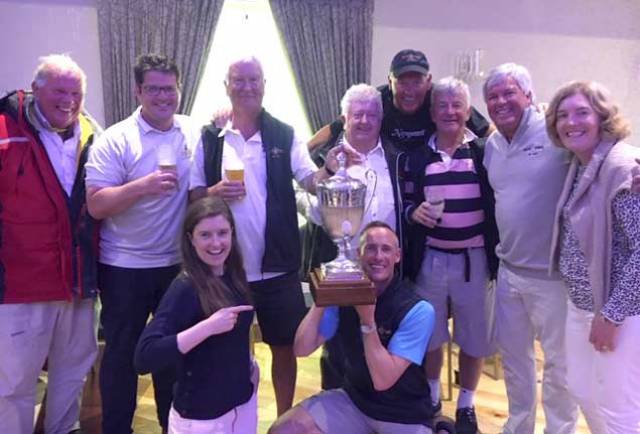 Still at it. Michael O’Leary (centre) in the midst of his shipmates after winning overall with the Dufour 44 Act Two in the 2019 Calves Week White Sails Division, thirty-five years after winning the Schull Centenary Regatta at the same venue with Imp
Still at it. Michael O’Leary (centre) in the midst of his shipmates after winning overall with the Dufour 44 Act Two in the 2019 Calves Week White Sails Division, thirty-five years after winning the Schull Centenary Regatta at the same venue with Imp
There were memories of all this last year when the same Michael O’Leary and partners were the White Sail overall winners at Calves Week in Schull with the Dufour 44 Act Two, but for me the sweetest memories of 1984 are of Cape Clear Regatta, which was organised by the late Derek Harte and his many friends with their “Cape Clear Advanced Regatta Computer”.
To everyone else, the Computer looked like a cardboard box with a tape coming out of it, with a long row of adhesive labels on the tape, each with the name of one of the entered boats. All of us got a prize of an attractive piece of locally-fired pottery. But as Teddy Crosbie had sailed a blinder with his Sadler 32, he rightly got the Pope Cup for the overall winner, and all was well with the world.
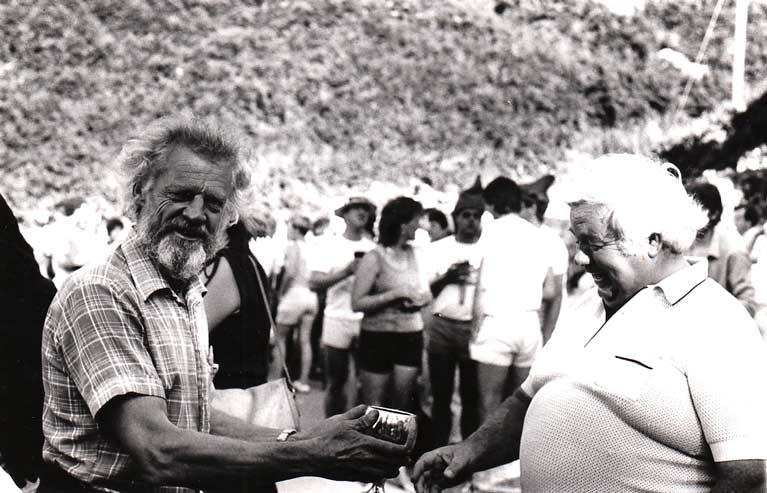 Derek Harte (left) presents Teddy Crosby with the Pope Cup for overall champion, Cape Clear Regatta 1984. Photo: W M Nixon
Derek Harte (left) presents Teddy Crosby with the Pope Cup for overall champion, Cape Clear Regatta 1984. Photo: W M Nixon
And if we have strayed more than somewhat from whether or not, once upon a time, there was a creature of significance in the seas around Baltimore called Albert, and whether or not he was a dolphin or a pilot whale or whatever, well so be it, that’s the way it is with West Cork.































































